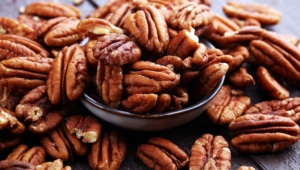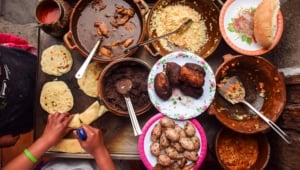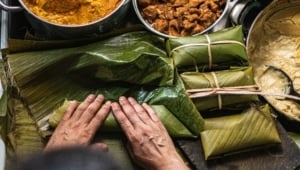Korean Food: 5 Popular Dishes + 7 Secret Recipe Tips

When people hear Korean food, they immediately think of kimchi and bibimbap. But, the cuisine has so much more to offer. Today, we’ll go on a journey through some of the most delectable Korean dishes out there. Join us, and learn how to make a few secret tips to help you master the cuisine.
Korean cuisine has a long and colorful history, filled with all sorts of spices and tasty treats. From red rice cakes to fried chicken, the options are endless. In this article, we’ll walk you through some popular Korean dishes. We’ll also talk about recipes so you can try out making these meals at home.
Traditional Korean Cuisine – More Than Kimchi and Bibimbap

Traditional Korean Cuisine – More Than Kimchi and Bibimbap
Most people around the world are familiar with kimchi. Thanks to social media, the spicy pickled cabbage dish has made quite a splash in the last few years. People from all over the globe rave about how it makes for the perfect side dish for any meal.
The same goes for bibimbap. This rice-based dish is a wonderful blend of simple flavors that are chock full of nutrients and vitamins that’s good for you.
Plus, it’s served with gochujang or fermented red chili pepper paste. So, it’s no surprise that people enjoy the meal for breakfast, lunch, dinner, or even brunch.
Yet, because of how famous these dishes are, people tend to forget that Korean cuisine has so much more to offer. There are countless other meals and recipes that deserve a moment in the spotlight. They’re a mix of bold flavors, blending salty, spicy, sweet, and sour elements seamlessly.
After hearing that, you may think Korean dishes are complex and difficult to make. But that’s not the case. In fact, the cuisine largely revolves around three main elements: rice, vegetables, and seafood.
Although South Koreans also like to incorporate meat into their cooking. Now, with some background on the cuisine, we’re ready to jump into a few exciting dishes. Join us as we navigate this tantalizing dance of exceptional flavor combinations.
Most Popular Street Food in Korea

Most Popular Street Food in Korea
There’s no better way to experience Korean cuisine than through street food. It’s a kind of magic that can soften the hearts of even the harshest food critics. All across the region, you can find pojangmachas.
These are tented spots on wheels or a street stall that sell a wide variety of street food. Let’s take a look at some of the dishes they have to offer.
Tteokbokki: Spicy Stir-fried Rice Cakes

Tteokbokki – Spicy Stir-fried Rice Cakes
If you’ve watched a Korean movie or drama, chances are you’ve seen tteokbokki somewhere in the background. That goes to show you how well-liked the dish is. It has consistently maintained its spot in the top five most-loved Koreaon street foods.
The dish consists of spicy rice cakes mixed with an array of toppings, like eggs and scallions. That makes for a soft, chewy dish that’ll keep you coming back for seconds.
Eomuk: Korean Fish Cake

Eomuk – Korean Fish Cake
South Korea is one of the world’s major deep-sea fishing nations. So, it’s no surprise that the area is overflowing with seafood. Because of that, eomuk is one of the most affordable street food options on the market.
It consists of ground seafood blended with a starchy ingredient. This gives us a doughy mixture that we can shape and then fry until golden brown. Finally, we dip the fish cakes in salty soy sauce seasoned with green onions and sesame oil.
With this dish, you can opt for a folded (zigzagged) or an elongated shape. The former packs more of an umami punch, but the latter stays hot and fluffy for longer.
Twigim: Korean Deep Fries
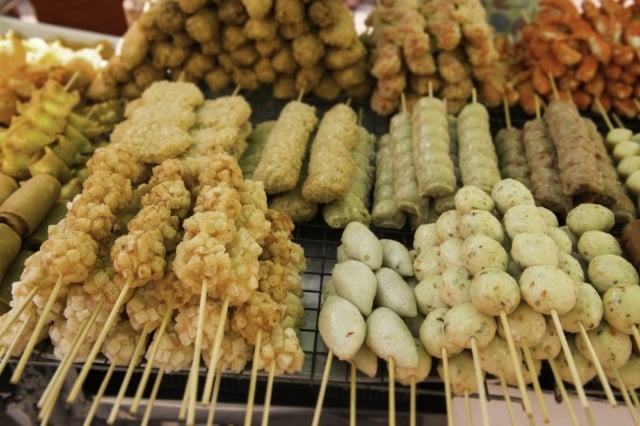
Twigim – Korean Deep Fries
If you’re a fan of deep-fried food, then twigim may be the perfect dish for you. It’s the Korean version of the better-known Japanese tempura. The main components of twigim will depend on the time of year. That’s because the dish relies on whatever ingredients are in season.
This can include squid, sweet potatoes, seaweed noodle rolls, and shrimp, just to name a few. Once you have your main components, you lightly coat them in a batter. It consists of starch powder, bread crumbs, and flour.
Lastly, you deep fry the dish to give you crispy bites that are ideal for snacking.
Gilgeori Toast: Korean Street Toast

Gilgeori Toast
Gilgeori toast is one of the most popular Korean street foods for a few reasons. For starters, it consists of a savory egg and vegetable patty sandwiched between two slices of ham.
Then, you add a heaping helping of cheddar cheese and drizzle a generous amount of ketchup and mayo. All of which ends up between two crispy, buttered slices of toast.
As you can imagine, this makes for a delectable meal. Besides that, gilgeori toast is exceptionally fast to prepare. So, you can grab a toast on your way to work or an important meeting.
Other than that, it’s one of the most affordable street foods available.
Soondae: Korean Sausage

Soondae
Soondae is the Korean version of blood sausage. The dish consists of cow’s or pig’s intestines stuffed with various ingredient combinations. It has a chewy, almost mochi-like texture and a subtle sweet and sour flavor profile.
Typically, we top soondae off with a sprinkle of salt and sugar, along with chili powder, sesame oil, and dried shrimp. That gives you an earthy, almost nutty aftertaste, which makes soondae the perfect companion for spicy tteokbokki.
Korean Food in the World

Korean Food in the World
Korean cuisine has expanded its presence worldwide over the past few years. We can attribute that to the growing popularity of Korean media like K-pop, movies, and dramas. Today, the cuisine is rising as the new Asian flavor plate in the global food scene.
Soon, many cultures from across the world began incorporating Korean elements into their dishes. That includes existing meals like fried chicken and barbeque, which paved the way for several Korean fusion meals that we all know and love.
Because of that, the cuisine made its way around the globe, and it’s showing no signs of slowing down.
Differences Between North Korean and South Korean Food

Differences Between North Korean and South Korean Food
While North and South Korean cuisines share many elements in common, there are quite a few differences between the two. For instance, South Korean dishes tend to be much more spicy. The locals prefer a fiery kick to their meals.
Other than that, North Koreans rely on fermented bean paste (doenjang) rather heavily in their cuisine. In contrast, South Koreans prefer to use red pepper paste. This isn’t a massive difference, but it alters the base flavor profile of many dishes.
Moving on, there are a few aesthetic differences between Northern and Southern cuisine. This is incredibly apparent in the dumplings in each region. For starters, most of the time, South Korean dumplings take on simple forms. That includes crescent and round shapes.
As for North Korean dumplings, they’re like tiny works of art. Traditionally, they’ll have intricate designs and can look like flowers, leaves, and stars.
Plus, North Koreans aren’t big fans of mustard. So, when it comes to dipping sauces, they usually stick to standard soy sauce or vinegar. Finally, Northerners don’t consume beef. Instead, they like to eat chicken or pork belly.
How Healthy Is Korean Food?

How Healthy Is Korean Food?
Most people consider the traditional Korean diet to be a relatively healthy option. That’s because it’s centered around vegetables, fermented foods, soups, rice, and seafood. This makes for a well-balanced diet that contains most of the nutrients you need to stay healthy.
On top of that, the majority of Korean dishes don’t call for a lot of oil. For that reason, they’re often lower in calories than traditional American meals. So, if you’re trying to lose weight, this cuisine can help you get started.
Plus, as we mentioned, Koreans like their food spicy. Thankfully, the compound that gives food a fiery kick (capsaicin) is good for you. It can help regulate your weight, blood pressure, blood sugar, and blood fat levels.
Moving on, fermented foods, like kimchi, can offer you countless health benefits. For example, the pickled cabbage dish contains probiotics or gut-friendly bacteria. These microorganisms can support your immune system and reduce risk factors for heart disease.
However, not all aspects of the Korean diet are healthy. Sadly, many dishes tend to be high in salt, which can be a significant problem for someone who struggles with high blood pressure.
It can be a little tricky to decide if a dish is good for you or not. So, to make your life a bit easier, here are a few healthy Korean food options to get you started:
- Kimbap/Gimbap: These are seaweed and rice rolls reminiscent of sushi.
- Tofu stew: It consists of soft tofu and mushrooms, resulting in hearty, spicy soup.
- Steam vegetable dishes: Vegetables are generously seasoned and then steamed until softened.
- Soy milk noodle soup: A lighter version of ramen noodles that’s ideal for an afternoon snack.
- Kimchi: There’s no better side dish than these spicy pickled cabbages.
Famous and Popular Korean Dishes You Have to Try

Famous and Popular Korean Dishes You Have to Try
Food is more than just a bunch of ingredients thrown on a plate. It tells the story of an area’s history and rich cultural heritage. Luckily, Korean cuisine perfectly embodies what it’s like to live in the region. It’s slightly exotic, with various appetizing flavor combinations to try.
In this section, we’ll cover a few meals that are famous all around Korea. From savory snacks to sweet confections, there’s an option for everyone. So, without further ado, let’s dive into five Korean dishes that’ll make your palate sing.
Ramen

Ramen
Most people around the world are familiar with ramen. This quick and easy noodle dish got many of us through countless sleepless nights. It’s the definition of comfort food in Asian cuisine. Well, there’s a Korean version of the dish known as ramyeon.
It’s a simple and affordable meal that you can customize to match your preferences. For example, you can add all sorts of herbs and spices and a variety of toppers.
That includes eggs, mushrooms, chicken, or other vegetables. Each ingredient will add a special flavor and texture twist.
Besides that, there are soupy and dry versions of ramyeon. So, you can choose to eat it with a flavorful broth for a hearty meal or just the noodles for a fast energy boost.
Japchae

Japchae
Japchae is another noodle-based dish with an interesting flavor profile. The main ingredient in the meal is glass noodles. These are made out of starch and water, so they’re much lighter than traditional pasta. Plus, they’re transparent, which makes for a visually appealing dish.
After you soak the noodles to soften them, you stir-fry them with a bunch of other ingredients. That may include bell peppers, sesame seeds, and spinach.
You can even add pork or chicken to add another layer of zest. This makes for a well-balanced dish that packs a major flavor punch.
Finally, some people like to sprinkle a little sugar on top. That gives it a sweet twist that helps bring out the savory notes in the meal.
Gyeran Mari

Gyeran Mari
If you’re looking for a quick and nutritious breakfast, gyeran mari may be the way to go. It’s a dish made of rolled omelets with vegetables mixed in. For instance, a traditional gyeran mari includes carrots, tomatoes, bell peppers, onions, and spam.
This makes for a mild meal full of a wide variety of minerals and vitamins. On top of that, the dish is fluffy and light. So, it’ll get you energized for the day without weighing you down.
Moving on, you can also serve gyeran mari as a side dish. The mild nature of the omelet can complement the rich, spicy flavors of most Korean meals.
Some people like to add seafood to their omelets, like salted fish. This gives the dish a savory twist that’s hard to beat.
Budae Jjigae
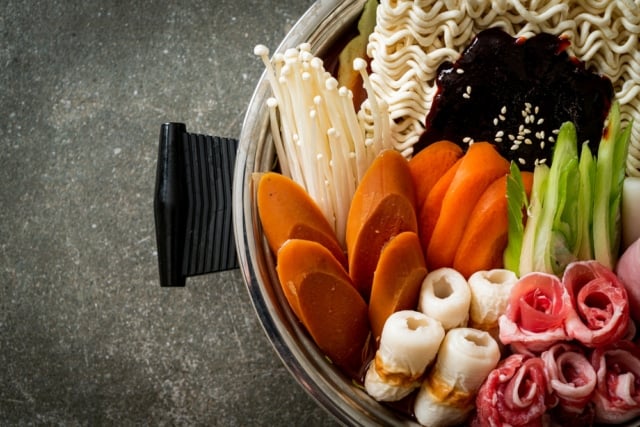
Budae jjigae
Budae jjigae, or army stew, has an interesting backstory. After the war that divided Korea into two regions, North and South, resources were scarce. That’s especially true when it comes to food. People struggled to get their hands on nutritious ingredients.
So, the locals had to get creative. They combined any ingredients they could get their hands on into a stew. That included eggs, spam, instant noodles, various vegetables, and chicken, which made for a hearty meal that can fill up anyone in a flash.
One of the best aspects of this dish is that it’s completely customizable. You can add as many components as you want and substitute ingredients that you don’t like. This versatility is the secret behind budae jjigae’s popularity.
Bingsu

Bingsu
Most of the dishes we’ve talked about so far have been savory meals. Yet, Korea also has a lot to offer in terms of desserts. A great example of that is bingsu. It’s a shaved ice treat that consists of milk, condensed milk, fruit syrup, and other sweet toppings.
This is similar to ice cream in flavor, but the texture is wildly different. bingsu can range from tiny snowflakes to fluffy layers of thin ice. That means it’s much lighter than regular ice cream.
Aside from that, red bean paste is the most common topping for this dessert. It gives the dish a nutty flavor that boosts the sweetness of the sweet treat. Plus, you can add chopped fruits on top to give your dessert a fresh aftertaste.
Soups & Salads

Soups & Salads
Traditionally, people serve soup as a part of the beginning or end of a meal. However, that’s not the case with Korean cuisine. In this Asian region, soup makes up a significant portion of the main course.
So, no conversation about Korean cuisine is complete without mentioning the wonderful soups the area has to offer. There are many stews with unique flavor profiles that are incredibly popular in Korea.
A great example of that is dak gomtang, or chicken soup. This may seem like an oddly tame choice, but wait until it hits your taste buds. The combination of chicken broth, spring onions, and spices makes for an exceptionally soothing and comforting dish.
Yet, the best part about this meal is that you can make it with common ingredients found in everyone’s pantry. So, you won’t have to go on a special trip to the Korean grocery store.
Other than that, tteokguk, or rice cake soup is another popular dish. It’s similar to tteokbokki, but the cakes soak in a bold broth. Because of that, the rice cakes are tender. Plus, they absorb the soup, which means they pack a lot more flavor.
Some people also like to add dumplings to the mix to add an extra layer of texture variation.
Lastly, Korean cuisine offers a few salad types that can spruce up any meal. One of the most well-liked is spicy green onion salad. It’s crunchy with a fresh, zesty aftertaste. So, it makes for a light, refreshing lunch.
Starters, Sandwiches, Sides

Starters, Sandwiches, Sides
Appetizers play a significant role in any meal. They’re meant to whet your appetite and get you excited about the rest of the courses. Thankfully, Korean starters don’t disappoint. They’re all about celebrating diverse textures and flavors, making every forkful an amazing experience.
Kimchi pancakes are perfect examples of that. When you hear pancakes, you expect to get a sweet treat drenched in syrup. Yet, that’s not the case with this dish. Kimchi pancakes are much flatter and crispier, with a savory flavor palate.
They’re spicy, with a hint of sourness, which makes them the ideal companion for any fatty meal. So, for your next barbeque, you may want to whip up a batch of kimchi pancakes.
Besides that, Korean cuisine has a lot to offer when it comes to sandwiches. One of our favorite examples is the inkigayo sandwich. It’s a triple-decker with three layers of thin filling.
Usually, it’ll consist of potato egg salad, strawberry jam, and imitation crab coleslaw wedged between two slices of soft toast.
At first glance, this may seem like a strange combination of flavors. But, they work so well together. The sweet jam cuts through the tanginess of the potato egg salad and balances out the dish beautifully.
Finally, every Korean dish needs a trusty sidekick to elevate the flavor profile. That’s where side dishes, or banchan, come into play. These are savory additions that round out the culinary experience of Korean food.
Some of the most notable banchan include pickled radishes, scallion pancakes, and kimchi.
Mains

Mains
When it comes to Korean mains, there are several dishes that’ll have your taste buds doing somersaults of joy. Brace yourself, because your mouth is about to start watering.
Right off the bat, Korean main meals are normally made from grains like rice (bap), porridge (juk), or noodles (guksu). For instance, one of the most widely consumed dishes is gochujang fried rice.
It’s easy to prepare and you can use any ingredients you have lying around in your pantry.
Moving on, bibimbap is another well-liked main dish for a couple of reasons. For starters, all the ingredients of the dish are readily available and affordable. Besides that, the meal can feed a large crowd.
Plus, it’s incredibly customizable. You can add or remove components to tailor the dish to your preferences.
Other than that, there are a few main dishes with protein as the star of the show. First up, we have the infamous beef bulgogi. The name translates to fire meat. So, as you can guess, this dish is all about barbeque.
We make the meal using thinly sliced meat that we marinate in a special sauce. That makes for tender bites that pack a major flavor punch.
Next, we have to mention Korean fried chicken. These crispy cutlets come with a variety of sauces that can transform their flavor profile. That includes honey garlic sauce, ginger and soy sauce, and gochujang.
Bread, Pastries, Dessert

Bread, Pastries, Dessert
Even though bread isn’t a main part of Korean cuisine, there are still quite a few options you can enjoy.
For instance, gyeran bbang, or egg bread, is a soft, almost toast-like loaf that you can find anywhere in Korea. It has a mild flavor, which means it’s ideal for dipping into sauces and making sandwiches.
Aside from that, Korean cuisine gets to truly shine with pastries. It offers countless exceptional baked goods that can work for any occasion. An excellent example of that is hwangnam or gyeongju bread. It’s a bun filled with red bean paste.
This gives it a slightly sweet aftertaste. Because of that, you can eat the buns as a nutritious breakfast, or as a tasty treat to round out a full meal.
Next, let’s dive into the magical realm of Korean desserts. When it comes to confections, the cuisine has plenty to offer. From small delicate desserts to intricate works of sugar art, the options are endless.
For a simple dessert, you can opt for fish-shaped pastries or bungeoppang. This confection comes with various fillings, each with a unique flavor profile. Moving on, there are a few fancy desserts that you can enjoy like Korean poached pears or baesuk.
You let the fruit simmer in a liquid of your choice with a mixture of herbs and spices. That’ll soften the pears and infuse them with a ton of flavor.
Then, you top it off with some whipped cream or fresh fruit. That makes for a warm dessert that can leave you feeling cozy and relaxed.
Secret Recipe Tips

Secret Recipe Tips
Now, this is the part you’ve all been waiting for. In this section, we’ll cover a few secret tips and tricks that can help you master Korean cooking in a flash. Join us as we go through the full rundown.
Source the Best Ingredients

Source the Best Ingredients
No matter what type of cuisine you’re cooking, your dish will only ever be as good as the ingredients. The components will dictate the flavor profile and the final outcome of your meal. That’s why it’s crucial to source the best ingredients available.
So, you may want to take a short trip to your local farmers' market. Besides that, it may be a good idea to visit your local Korean grocery store.
This shop should have everything you need to prepare a traditional Korean meal from scratch. That includes fresh produce and specialty ingredients like gochujang.
Make Use of Texture Variation

Make Use of Texture Variation
One of the most interesting aspects of Korean cuisine is the texture variation. Many dishes rely on a mixture of soft, chewy, and crunchy elements that all come together seamlessly. Not only does that make for a more enjoyable mouthfeel, but it can also change the flavor profile of your dish.
To make this a little clearer, let’s take a look at an example. With bibimbap, the main part of the dish is chewy rice. Then, the white grain is topped off with some crunchy veggies and a hard-boiled egg with a runny yolk.
As you can tell, this meal has quite a few different textures. Yet, they all come together to deliver one tasty meal. So, don’t be afraid to mix and match textures to get the best Korean dish possible.
Spices Are Your Friends

Spices Are Your Friends
Spices can be very polarizing. Most people think that they’re essential to spruce up any dish and, without them, meals fall flat. On the other hand, some feel like spices overwhelm a dish and distract from the other ingredients.
Well, if you want to try out cooking Korean cuisine, you have to learn to love spices. The cooking style relies heavily on all sorts of different flavor enhancers like sesame oil, gochugaru, and ginger.
When you first start cooking Korean cuisine, it’s best to follow the recipe to the letter. Then, as you gain a little experience, you’ll be able to experiment with spices to match your preferences.
Don’t Be Afraid to Mix Sweet and Savory Elements

Don’t Be Afraid to Mix Sweet and Savory Elements
You’ll notice from the dishes we previously talked about, many Korean meals blend savory and sweet elements. At first, this combination may seem jarring, but there’s a method behind the madness.
With Korean food, the locals will use a variety of spices to add a little excitement to a dish. Then, they’ll sprinkle on a bit of sugar to balance out the sharpness of the meal. Yet, the sweet ingredient has one other function.
Sugar can thicken a dish and give it a stickier texture. This will help the ingredients cling to each other, which should make using chopsticks much easier.
Pay Close Attention to the Texture of Rice

Pay Close Attention to the Texture of Rice
Rice is one of the most commonly used ingredients in Korean cuisine. It’s the centerpiece of all Korean food, including breakfast, lunch, and dinner. Because of that, you have to master achieving the perfect rice texture.
Ideally, after you cook the grains, they should maintain a subtle bite. Other than that, the rice should be sticky and slightly chewy. To do that, you have to boil, simmer, and steam the rice. This means there are quite a few steps that you need to learn.
It can take several tries before you make the rice just right. So, be patient, and don’t be afraid to try again if your first attempt isn’t on the money.
Fermentation Is Your Friend

Fermentation Is Your Friend
In Korean cuisine, baking and frying aren’t common cooking methods. Instead, the style relies on boiling, blanching, seasoning, and pickling. These are simple to learn and can help you achieve all sorts of flavors and textures.
Yet, if you take a closer look at Korean ingredients, you’ll notice many of them are fermented. A few examples of that include gochujang, gochugaru, and kimchi. This begs the question: why does Korean cuisine rely heavily on fermented components?
Luckily, the answer is simple. For starters, fermentation preserves ingredients, so they’ll last on your shelves for a lot longer. Other than that, the fermentation process can enrich the flavors of certain components.
Use Gochugaru Wisely

Use Gochugaru Wisely
We’ve mentioned several times how Koreans like their food on the spicier side. That’s why many recipes call for gochugaru. It’s the Korean version of red chili pepper powder. This ingredient is a bit sweet and smokey, with a fiery aftertaste.
People classify gochugaru as mildly spicy. Yet, if you’re not used to eating hot food, the ingredient may be overwhelming. For that reason, it’s a good idea to taste the powder before you start cooking with it. That’s especially true if you plan to feed your Korean creations to children.
Beverages

Beverages – Soju
After all this food talk, we can move on to discussing beverages. There’s no better way to wash down a Korean meal than with a traditional Korean drink. Thankfully, there are hundreds of options for you to choose from.
First up, banana milk (banana mat uyu) is arguably the most popular Korean beverage. This may seem a little boring or underwhelming, but just wait until you try it. For starters, the drink has a mild, sweet flavor that can coat your entire mouth.
This blends beautifully with most of the herbs and spices found in Korean dishes. Other than that, we all know that milk is one of the best ways to soothe your mouth after a fiery meal. So, Koreans drink banana mat uyu to help them cut through the spiciness of certain dishes.
Besides that, there’s sikye, which is a beverage made from fermented malt and rice. Although, this drink is exceptionally sweet. So, it may serve better as a dessert than a beverage.
Finally, we have to mention soju when talking about Korean beverages. This is the most popular liquor in this Asian region. It’s a clear, slightly sweet spirit that goes well with almost any meal.
Ingredients

Ingredients – Doenjang
If you’ve ever wondered what makes Korean cuisine so tasty, the secret is in the ingredients. The cooking style relies on a wide variety of special components that can elevate the flavors of a dish and leave you asking for seconds.
Here are a few common ingredients that can make mastering Korean cuisine a breeze:
- Doenjang: This is a spice made of fermented soybeans. It’s a bit savory and packs one mean umami-rich punch. Because of that, it’s ideal for stews, ramen, and even wraps.
- Ganjang: This is the Korean version of soy sauce. It’s a nice blend of savory and sweet notes. That’s why people use it as a flavoring and a dipping sauce.
- Aekjeot: Seafood is one of the main pillars of Korean cuisine. So, it’s no surprise that fish sauce is a popular ingredient. Koreans like to use it in kimchi because it can speed up the fermentation process.
Herbs and Spices

Herbs and Spices
The Korean palate is chock full of subtle layers of flavors that all work together to create a magical culinary experience. To achieve this effect, Korean cuisine uses a fine, intricate artwork of herbs and spices.
Each one plays a fascinating role and chimes in tantalizing flavor notes that make this cooking style unique and scrumptious. Here are a few common herbs and spices that’ll level up your Korean dishes:
- Ginger powder: This powder is a bit peppery and almost spicy. Because of that, it works well in marinade sauces, kimchi, and even in some Korean teas.
- Garlic chives: These are tender herbs with a hint of garlic aftertaste. This makes for the perfect addition to Korean salads, pancakes, and kimchi.
- Mustard seed powder: This spice has a zesty flavor with mild earthy undertones. A small pinch can add a unique freshness to your dishes. You can incorporate it in salads, noodle dishes, and bibimbap.
Korean Food Culture

Korean Food Culture
The food culture in Korea is deeply rooted in tradition and plays a significant role in the region’s identity. It’s like a well-stirred family-sized pot of local traditions, Asian influences, and a splash of distinct flavor combinations.
Even if you’ve had plenty of Asian food, Korean food still manages to stand out with its signature dishes and flavor twists. It paints a tantalizing canvas that encourages you to explore Korean history through the cuisine.
On top of that, the region has its own set of habits and etiquette rules. So, before you go on a journey through Korean cuisine, it’s a good idea to familiarize yourself with these traditions.
Eating Habits

Eating Habits
For Korean locals, food is more than just sustenance. It’s a way for people to share their lives, exchange stories, and celebrate important moments. Because of that, most people in the region prefer to dine in groups.
For instance, it’s normal for family members to have breakfast and dinner together. Plus, children will have lunch with their classmates and the parents will eat with their co-workers.
Besides that, Koreans like to experience an array of flavors in every bite. So, it’s common for them to eat all the available dishes at the same time. That may mean that they’ll have a bite of dessert right in the middle of dinner.
Meal Structure

Meal Structure
The basic cuisine structure in Korea revolves around rice, vegetables, and seafood. So, it’s common that you see all of these elements present in every meal. Besides that, dairy is mostly absent from Korean cooking. That’s because many locals are lactose intolerant.
A typical Korean dinner may look something like this: a bowl of rice, a bowl of soup or stew, and a wide array of banchan. This makes for a delicious, well-balanced meal.
Etiquette

Etiquette
Respect is a major defining characteristic of Korean culture. So, it’s no surprise that locals approach eating with a similar regard. Koreans have strict etiquette rules that help turn every meal into a harmonious experience.
For example, when eating around Koreans, it’s customary to monitor how fast you eat. You don’t want to eat too slowly, or it may seem like you’re not enjoying the food.
Other than that, it’s impolite to eat too quickly and make a mess. So, be sure to pace yourself and enjoy the food while you eat.
Aside from that, it’s best to stay as quiet as possible while eating. That means your spoon should never touch your bowl and make a crashing sound.

